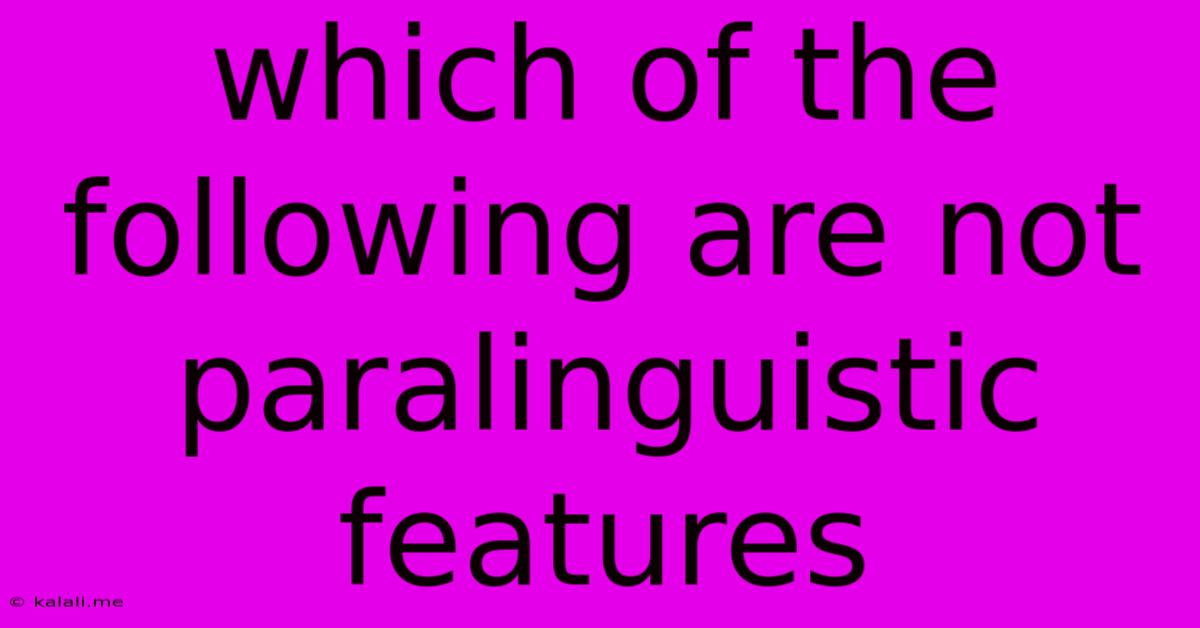Which Of The Following Are Not Paralinguistic Features
Kalali
Jun 14, 2025 · 3 min read

Table of Contents
Which of the Following Are NOT Paralinguistic Features? Understanding Nonverbal Communication
Paralinguistics is the study of nonverbal elements of communication that influence meaning. These elements accompany speech, altering its interpretation and adding layers of meaning beyond the words themselves. But what isn't considered paralinguistic? This article clarifies the boundaries of paralinguistics and explores examples of features that fall outside its scope.
Understanding paralinguistics is crucial for effective communication, whether in personal interactions, professional settings, or public speaking. Mastering both verbal and nonverbal cues enhances clarity, builds rapport, and improves the overall impact of your message. This article will help you differentiate between true paralinguistic features and other forms of nonverbal communication.
What are Paralinguistic Features?
Paralinguistic features are aspects of spoken communication that aren't strictly linguistic, meaning they're not about the words themselves. Instead, they focus on how something is said, rather than what is said. Key examples include:
- Tone of Voice: This encompasses intonation, pitch, and inflection, which can drastically change the meaning of a sentence. A simple "hello" can sound friendly, sarcastic, or inquisitive, depending on the tone.
- Volume: Speaking loudly can convey excitement or anger, while a whisper might suggest secrecy or intimacy.
- Pace/Speed: A rapid pace might indicate nervousness or urgency, while a slow pace can suggest calmness or importance.
- Pauses and Hesitations: These can signal thoughtfulness, uncertainty, or emphasis.
- Vocal Fillers (e.g., "um," "uh"): While often considered undesirable, these are paralinguistic features that reflect the speaker's thought process and fluency.
- Stress and Emphasis: Highlighting certain words alters the meaning and focus of a sentence.
- Intonation: The rise and fall of pitch during speech.
Features That Are NOT Paralinguistic:
While many nonverbal cues contribute to communication, not all are paralinguistic. The following are examples of nonverbal features that fall outside the realm of paralinguistics:
- Body Language (Kinesics): This includes gestures, posture, facial expressions, and eye contact. While closely related to communication and impacting its interpretation, kinesics is a separate category from paralinguistics. A smile, a frown, or a crossed arm are all examples of kinesics, not paralinguistics.
- Proxemics (Use of Space): The distance maintained between speakers conveys information about the relationship and context. Standing too close or too far can significantly impact communication, but it isn't a paralinguistic feature.
- Haptics (Touch): Physical touch, such as a handshake or pat on the back, is a powerful nonverbal cue, but distinctly different from paralinguistics.
- Chronemics (Use of Time): Punctuality or lateness, the speed of conversation, and pauses between turns can influence communication, yet they are not considered paralinguistic elements.
- Artifacts (Personal Objects): Clothing, jewelry, or other personal possessions can communicate information about the speaker, but are not directly paralinguistic.
The Interplay of Verbal and Nonverbal Communication:
It's important to remember that verbal and nonverbal communication work together. Paralinguistic features are intertwined with the spoken words, while other nonverbal elements contribute independently. A mismatch between verbal and nonverbal cues can create confusion or even distrust. For instance, saying "I'm fine" with a shaky voice and slumped posture contradicts the verbal message.
Conclusion: A Holistic Approach to Communication
Understanding the difference between paralinguistic features and other forms of nonverbal communication allows for a more nuanced approach. Effective communication requires a holistic understanding of both the spoken word and the accompanying nonverbal cues, creating a richer and more impactful message. Mastering these elements will improve your communication skills across various settings and contexts.
Latest Posts
Latest Posts
-
Identify And Describe The Five Characteristics Of Adolescence
Jun 15, 2025
-
A Body Of Land Surrounded By Water On Three Sides
Jun 15, 2025
-
What Is The Lcm Of 3 And 16
Jun 15, 2025
-
Sat Scores For University Of Houston
Jun 15, 2025
-
Difference Between Express Contract And Implied Contract
Jun 15, 2025
Related Post
Thank you for visiting our website which covers about Which Of The Following Are Not Paralinguistic Features . We hope the information provided has been useful to you. Feel free to contact us if you have any questions or need further assistance. See you next time and don't miss to bookmark.